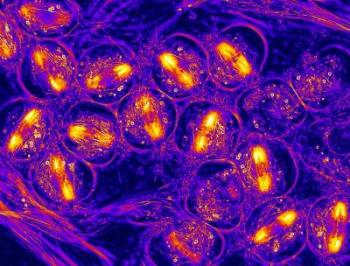Feb 18 2013
When difficult biological questions are tackled by creative experts in physics, what can result? Images of great beauty, accessible for anyone to appreciate, that also offer rich information on fundamental life processes, and rewarding new paths for analysis and insight.
 These are spermatocytes from the crane fly, Nephrotoma suturalis. This image was generated using a Nikon Microphot SA equipped with a liquid crystal universal compensator, a so-called LC-PolScope (Cambridge Research and Instrumentation, Woburn MA). Credit: Rudolf Oldenbourg/MBL
These are spermatocytes from the crane fly, Nephrotoma suturalis. This image was generated using a Nikon Microphot SA equipped with a liquid crystal universal compensator, a so-called LC-PolScope (Cambridge Research and Instrumentation, Woburn MA). Credit: Rudolf Oldenbourg/MBL
This leading edge of interdisciplinary collaboration in microscopy will be explored in "Innovations in Imaging: Seeing is Believing," Saturday, February 16, 1:30-4:30 PM at the AAAS Annual Meeting in Boston.
The panel will feature three physicists and three biologists, several of whom are affiliated with the Marine Biological Laboratory (MBL) in Woods Hole, Mass., a leading center for innovation in biophysics and biological imaging (see list below).
"We are beginning to understand the basis for cell organization at unprecedented spatial and temporal resolution through the creative application of fundamental physics to microscopy," states session organizer Amy S. Gladfelter of Dartmouth College and MBL. "This symposium will help motivate the next phase of interdisciplinary approaches to advance the visualization of life, from the scale of a single molecule to the whole organism."
The data collected in biological images, Gladfelter notes, not only bring insight to basic cell processes, but can also be used for medical purposes (to diagnose a metastasizing cancer or microbial infection, for example, or to screen chemical libraries for new pharmaceuticals).
"These images also bring us to a beautiful world beyond the grasp of our normal senses," Gladfelter states. "In this way microscopes give us beauty and [biological or medical] application, often in the same image."
The capacity of microscopes to reach beyond the senses is well appreciated by MBL Senior Scientist Rudolf Oldenbourg, who will address "New Frontiers in Polarized Light Microscopy for Live Cell Imaging" in this session:
"Polarization is a basic property of light that is often overlooked, because the human eye is not sensitive to polarization. Therefore, we don't have an intuitive understanding of it and optical phenomena that are based on polarization either elude us or we find them difficult to comprehend," Oldenbourg states.
"Like most scientific instruments, the polarized light microscope translates polarization effects so they can be perceived by our senses, in this case by our eyes, and makes them amenable to quantitative and analytical analysis. At the MBL, we are developing polarized light imaging techniques … that clearly reveal the otherwise invisible dynamics of single molecules and molecular assemblies in organelles, cells, and tissues."
Other talks in the session will include:
"Navigating the Dynamic Cell"
Jennifer Lippincott-Swartz (National Institutes of Heath/MBL Physiology Course)
"Imaging Three-Dimensional Dynamics in Cells and Embryos"
Eric Betzig (Howard Hughes Medical Institute/MBL Physiology Course and MBL Neurobiology Course)
"Structured Illumination and the Analysis of Single Molecules in Cells"
Rainer Heintzmann (King's College, London)
"Imaging Single Cells in the Breast Tumor Microenvironment"
John Condeelis (Albert Einstein College of Medicine)
"Single Molecule Imaging in Live Cells"
Amy S. Gladfelter (Dartmouth College/MBL Whitman Investigator)